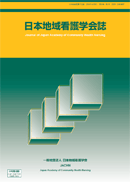Volume 14, Issue 1
Displaying 1-9 of 9 articles from this issue
- |<
- <
- 1
- >
- >|
-
Article type: Article
2011 Volume 14 Issue 1 Pages 20-29
Published: September 30, 2011
Released on J-STAGE: April 20, 2017
Download PDF (1243K) -
Article type: Article
2011 Volume 14 Issue 1 Pages 30-39
Published: September 30, 2011
Released on J-STAGE: April 20, 2017
Download PDF (1110K) -
Article type: Article
2011 Volume 14 Issue 1 Pages 40-48
Published: September 30, 2011
Released on J-STAGE: April 20, 2017
Download PDF (1048K) -
Article type: Article
2011 Volume 14 Issue 1 Pages 49-54
Published: September 30, 2011
Released on J-STAGE: April 20, 2017
Download PDF (752K) -
Article type: Article
2011 Volume 14 Issue 1 Pages 55-61
Published: September 30, 2011
Released on J-STAGE: April 20, 2017
Download PDF (911K) -
Article type: Article
2011 Volume 14 Issue 1 Pages 62-70
Published: September 30, 2011
Released on J-STAGE: April 20, 2017
Download PDF (1070K) -
Article type: Article
2011 Volume 14 Issue 1 Pages 71-77
Published: September 30, 2011
Released on J-STAGE: April 20, 2017
Download PDF (805K) -
Article type: Article
2011 Volume 14 Issue 1 Pages 78-84
Published: September 30, 2011
Released on J-STAGE: April 20, 2017
Download PDF (846K) -
Article type: Article
2011 Volume 14 Issue 1 Pages 85-92
Published: September 30, 2011
Released on J-STAGE: April 20, 2017
Download PDF (949K)
- |<
- <
- 1
- >
- >|
